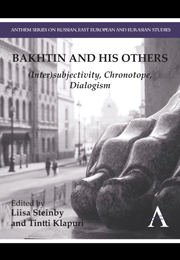Book contents
- Frontmatter
- Contents
- Acknowledgments
- Translation and Transliteration
- Introduction: The Acting Subject of Bakhtin
- Chapter 1 Bakhtin and Lukács: Subjectivity, Signifying Form and Temporality in the Novel
- Chapter 2 Bakhtin, Watt and the Early Eighteenth-Century Novel
- Chapter 3 Concepts of Novelistic Polyphony: Person-Related and Compositional-Thematic
- Chapter 4 Familiar Otherness: Peculiarities of Dialogue in Ezra Pound's Poetics of Inclusion
- Chapter 5 Author and Other in Dialogue: Bakhtinian Polyphony in the Poetry of Peter Reading
- Chapter 6 Tradition and Genre: Thomas Kyd's The Spanish Tragedy
- Chapter 7 Bakhtin's Concept of the Chronotope: The Viewpoint of an Acting Subject
- Chapter 8 The Provincial Chronotope and Modernity in Chekhov's Short Fiction
- List of Contributors
Chapter 3 - Concepts of Novelistic Polyphony: Person-Related and Compositional-Thematic
Published online by Cambridge University Press: 05 May 2013
- Frontmatter
- Contents
- Acknowledgments
- Translation and Transliteration
- Introduction: The Acting Subject of Bakhtin
- Chapter 1 Bakhtin and Lukács: Subjectivity, Signifying Form and Temporality in the Novel
- Chapter 2 Bakhtin, Watt and the Early Eighteenth-Century Novel
- Chapter 3 Concepts of Novelistic Polyphony: Person-Related and Compositional-Thematic
- Chapter 4 Familiar Otherness: Peculiarities of Dialogue in Ezra Pound's Poetics of Inclusion
- Chapter 5 Author and Other in Dialogue: Bakhtinian Polyphony in the Poetry of Peter Reading
- Chapter 6 Tradition and Genre: Thomas Kyd's The Spanish Tragedy
- Chapter 7 Bakhtin's Concept of the Chronotope: The Viewpoint of an Acting Subject
- Chapter 8 The Provincial Chronotope and Modernity in Chekhov's Short Fiction
- List of Contributors
Summary
Introduction: Polyphonies of the Novel
Chronotope, carnivalism and polyphony, or rather the polyphonic novel, are the three concepts which have made Bakhtin famous as a theoretician of the novel and which have been widely adopted in contemporary literary scholarship. Once become part of the toolkit of literary scholars, Bakhtin's concepts have taken on an academic life of their own: they have often been used in an approximate way, even misleadingly. Of these, ‘carnivalism’ and ‘chronotope’ are exclusively Bakhtinian while ‘polyphony’ has been applied as a musical analogy to literary structures by others as well.
That a literary work may be composed in analogy with a musical work is an idea beloved by the German Early Romantics. In this tradition the term ‘polyphony’ is used to refer to a literary structure considered as analogous to the structure of polyphonic music. Today, however, ‘polyphony’ is often seen as an exclusively Bakhtinian concept, overlooking the fact that the term has been used to refer to quite different aspects of a literary work of art. The Routledge Encyclopedia of Narrative Theory, as well as Vladimir Biti's dictionary of literary and cultural theory, for example, do not recognize any use of the term other than the Bakhtinian (Aczel 2005, 443–4; Biti 2001, 627–9).
- Type
- Chapter
- Information
- Bakhtin and his Others(Inter)subjectivity, Chronotope, Dialogism, pp. 37 - 54Publisher: Anthem PressPrint publication year: 2013
- 3
- Cited by



